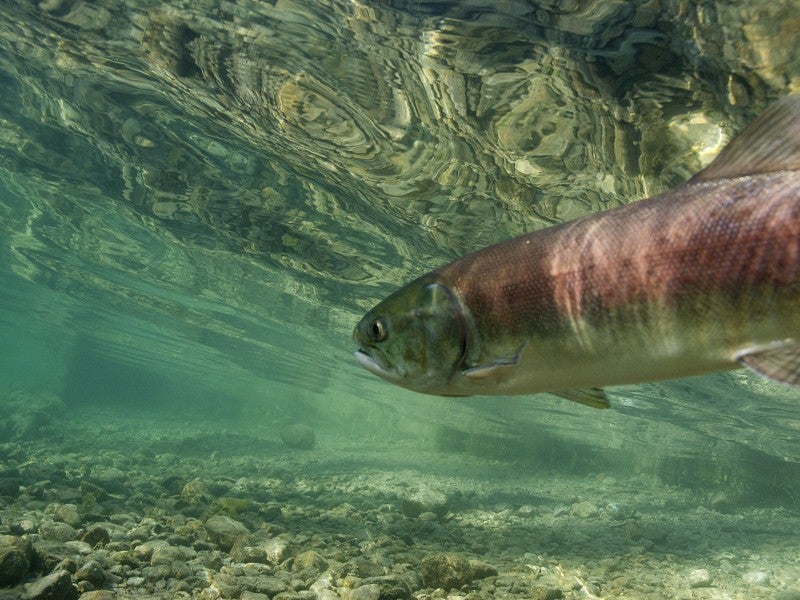Federal Agencies Seek Missoula’s Input on Wild Salmon Restoration Plan
Dam removal and other strategies will save federally endangered species
Contact
The Bonneville Power Administration, U.S. Army Corps of Engineers and U.S. Bureau of Reclamation will host a public meeting November 3 to seek public input on developing a new lawful, science-based plan to save endangered wild salmon and steelhead in the Columbia and Snake rivers. Residents of Missoula and surrounding areas who are impacted by the loss of wild salmon will attend the meeting, which is scheduled from 4 p.m. to 7 p.m. on Thursday, Nov. 3 at the Hilton Garden Inn Missoula, located at 3720 N. Reserve Street.
The Columbia/Snake Rivers of the Pacific Northwest is the most heavily dammed river system on earth.
The meeting is one of many scheduled in the wake of a U.S. District Court ruling last May that sent dam operators back to the drawing board and set a new planning process in motion. Finding in favor of fishing businesses, conservation groups, clean energy advocates, the State of Oregon, and the Nez Perce Tribe, that decision rejected the federal agencies’ previous salmon restoration plan as illegal, inadequate, and unrealistic—especially in the face of mounting climate impacts.
Meeting attendees in Missoula will urge federal agencies to initiate a new approach by taking action to remove four dams on the lower Snake River. Fisheries biologists have long highlighted this solution as the single most beneficial action to restore dwindling salmon and steelhead populations in the Columbia Basin. Wild salmon and steelhead are a valuable and cherished resource and a part of the natural heritage across the Northwest including Montana—particularly for fishermen who use and enjoy the Clearwater, the Lochsa and other tributaries to the Snake River.
The modest amount of power produced by the four lower Snake River dams can be affordably replaced with climate-friendly renewables that won’t harm fish. Montana’s wind resources can serve as an important component to this regional energy picture, as a complement to renewable wind and solar that is generated in Washington and Oregon.
“For too long, the federal agencies that manage the Columbia-Snake hydrosystem have erred on the side of preserving the status quo and refused to seriously consider the most promising salmon recovery measure available to us—restoring a free-flowing lower Snake River,” said Mike Fiebig, Northern Rockies Associate Director of American Rivers. “We hope the citizens of the Northwest states take advantage of this public process to state loudly and clearly that we can have plentiful wild salmon, abundant clean energy, and a thriving economy, but only if we follow the science and only if we work together.”
“It’s past time to remove the high-cost, low-value dams on the lower Snake River and allow wild salmon and steelhead to once again move freely to use the immense, high quality spawning and rearing habitat in the Rocky Mountains of central Idaho,” said David Merrill, Senior Organizing Representative of the Sierra Club in Missoula. “And it’s time to drop the Eastern Intertie charge and let Montana wind-electricity move fairly and freely over BPA’s transmission lines to replace that hydro power. The people of Montana welcome the opportunity to address the perilous decline of Northwest wild salmon stocks, relieve pressure on Libby and Hungry Horse reservoirs, and provide new excellent opportunities for Montana fossil fuel workers transitioning into the clean energy economy.”
“Salmon continue to languish on the brink of extinction, and time is running out for agencies to adopt a comprehensive, legitimate plan to bring them back,” said Earthjustice attorney Todd True. “Tools such as dam removal can restore rivers and bring fish back—faster and more successfully than even the scientists anticipated.”
“Removing four outdated and costly dams on the lower Snake River will pave the way for an economic revitalization for river towns like Clarkson, WA and Lewiston ID,” said Sam Mace, Inland Northwest Director of Save Our Wild Salmon. “Restoring salmon and steelhead to the Snake River basin will boost the fishing and recreation economies of eastern Washington and Idaho, and provide Montana anglers and outfitters more opportunities to chase steelhead and salmon. The federal agencies need to hear from Montana residents that they care about the rivers and fisheries on the other side of the Bitterroot Divide.”
“I am an enrolled Nez Perce tribal member and have been involved with our tribal membership and other like-minded groups to remove the four Lower Snake River dams for a number of years. The salmon have not recovered and have not met any return goals upriver in Nez Perce Treaty areas,” said Julian Matthews, board member of Nimiipuu Protecting the Environment. “The dams have created a nightmare for Salmon. Removing the dams is critical to the future of the Salmon and our people (the Nimiipuu) to practice a traditional subsistence that we have for time immemorial. Our Treaty Rights of the 1855 Treaty guarantees hunting, fishing and gathering rights. The removal of the four lower Snake dams will restore our ability to fulfill our Treaty right along the Columbia, Snake, Salmon and Clearwater Rivers. I am asking all Tribal members and allies to make your voice heard to remove these dams.”
Links to Reporter Resources

Additional Resources
About Earthjustice
Earthjustice is the premier nonprofit environmental law organization. We wield the power of law and the strength of partnership to protect people's health, to preserve magnificent places and wildlife, to advance clean energy, and to combat climate change. We are here because the earth needs a good lawyer.